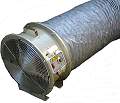
| ||||
W. Tombling Ltd.
Wembley House
Dozens Bank
West Pinchbeck
Spalding
Lincolnshire
PE11 3ND
U.K.


You are here:- home > cooling index > fan index > sizing ventilation fans
The need to ventilate
Ventilation is essential to create a comfortable working environment, whether it is to bring fresh cool air into a room or remove noxious fumes or vapours. For certain activities there is a legal requirement to provide a minimum level of ventilation, and the current Building Regulations now specify minimum levels of ventilation for new buildings.Natural ventilation
Natural ventilation relies on open doors and windows. Its performance depends on the size and position of the doors and windows, and natural airflow patterns. The results are highly variable, areas around doors and windows will be well ventilated, while pockets of stagnant or contaminated air can build up in other areas.Fan ventilation
Fan assisted ventilation overcomes these problems:
Portable purging fans and flexible ducting – provide a temporary solution for confined spaces such as tanks, sewers, tunnels, etc. delivering fresh air from outside.
Portable purging fans can also be positioned outside tents and marquees, delivering cooling air through flexible ducts.
Activair purging fans are available in 6 capacities from 2340 to 12,420 m3/hr. (cubic metres per hour).
Permanent wall mounted extractor fans – are aneconomical and efficient way to exhaust hot or stale air, fumes, or smoke from workshops, factories, warehouses, etc.
Activair extractor fans are available in three capacities – 2772, 4500 and 5580 m3/hr (cubic metres per hour).
Rate of ventilation
The rate of ventilation for an area is normally expressed in ‘air changes per hour’, i.e. the number of times per hour that the entire air volume of the area is changed.The rate depends of the type of room and the activity being undertaken. The following table lists suggested air changes per hour for some typical applications.
| Bakery | 20 - 30 |
| Canteen | 8 - 12 |
| Commercial kitchen | 30+ |
| Dairy | 8 - 10 |
| Electroplating shop | 10 - 12 |
| Engine room | 15 - 30 |
| Factory or workshop | 8 - 10 |
| Fume cupboard | 40 - 50 |
| Foundry | 8 - 15 |
| Garage | 6 - 8 |
| Spray booth | 20 - 50 |
| Warehouse or store | 3 - 6 |
Calculating the size of fan needed
Calculate the volume of the room in cubic meters by multiplying its length x width x height. Then multiply the room volume by the required number of air changes per hour, i.e.Fan volume (m3/hr) = Length(m) x Width(m) x Height(m) x air changes per hourExample. A workshop measuring 10m by 8m by 3m requires ventilating due to a build up of fumes and heat. The recommended number of air changes per hour is 8 – 10, to ensure adequate ventilation the higher figure will be used.
Fan volume (m3/hr) = 10 x 8 x 3 x 10 = 2400m3/hr.Selecting a fan that exceeds this value will ensure good ventilation.
Practical considerations
To allow displaced air to leave the room and fresh air to enter, it is important that doors and windows are left open. If this is not practical additional vents will need to be fitted.When using portable purging fans with flexible ducting, make sure the duct run is as short and straight as possible. Long runs and tight bends put pressure on the fan restricting the airflow. Where it cannot be avoided it is good practice to oversize the fan.
Wall extractor fans should be mounted adjacent the machinery or manufacturing processes causing the fumes or heat. When they are being used for general ventilation fit them near the ceiling, at the opposite end of the room from the doors and windows.
You are here:- home > cooling index > fan index > sizing ventilation fans
If you found this page useful, please take a moment
to tell a friend or colleague about it.
Copyright © 2004/6, W. Tombling Ltd.